Star gazing in Austin offers a multitude of celestial wonders for both seasoned astronomers and casual sky-gazers alike! With a mix of urban observatories and darker skies just outside the city, the opportunities to witness the beauty of the cosmos are vast and varied.
Your journey through the Austin night sky can include anything from educational star parties at local universities to a cozy evening spent outdoors with your family.
No matter your experience level or area of interest, there’s a stargazing experience waiting just for you in the Lone Star State’s capital city.
In a Nutshell
- Austin offers urban observatories and darker sky sites in Texas State Parks for various stargazing experiences.
- The city hosts educational star parties and events catering to all experience levels.
- Enjoy family-friendly activities and unique astronomical phenomena beyond Austin’s city limits.
In this article, you get to
Discover the best star gazing spots in and around Austin, Texas.
Learn about a variety of stargazing experiences for both seasoned astronomers and beginners.
Explore Austin’s urban observatories and darker sky sites, each offering unique celestial views.
Participate in educational star parties and events catered to all experience levels.
Find family-friendly activities and witness amazing astronomical phenomena outside Austin’s city limits.
Explore 29 exceptional stargazing locations, including parks, observatories, and natural areas.
Learn about star parties and festivals in the Texas Hill Country for optimal stargazing.
Gain insights on combatting light pollution to enhance your stargazing experience.
Discover astronomical phenomena like meteor showers and night sky photography opportunities.
Explore stargazing activities tailored for kids and uncover kid-friendly stargazing locations in Austin.
By the end of this article, you’ll have a comprehensive guide to the best stargazing spots in Austin, along with tips for enjoying celestial events, combatting light pollution, engaging kids in astronomy, and capturing the wonders of the night sky through photography.
Let’s dive right in.
29 Best Star Gazing in Austin

In this section, I cover my 29 favorite stargazing spots in Austin. For each location, you get a brief description of where it’s located, what makes it a special place to visit during the daytime, and why it’s unique for stargazing.
The best stargazing in Austin
- Austin Community College, Round Rock
- Big Bend National Park
- Blanco State Park
- Canyon of the Eagles Resort
- Devil’s Cove
- Dripping Springs
- Eagle Eye Observatory
- Enchanted Rock State Natural Area
- Fountainwood Observatory
- Friendship Park
- Garner State Park
- Granger Lake Dam
- Hamilton Pool Preserve
- Hill Country State Natural Area
- Inks Lake State Park
- Lake Pflugerville
- Lost Maples State Natural Area
- Mansfield Dam Park
- McDonald Observatory
- McKinney Falls State Park
- McKinney Roughs Nature Park
- Mount Bonnell
- Pedernales Falls State Park
- Reimer’s Ranch Park
- South Llano River State Park
- St Edwards Park
- The City of Elgin
- University of Texas, Austin
- Westcave Outdoor Discovery Center
Austin Community College, Round Rock
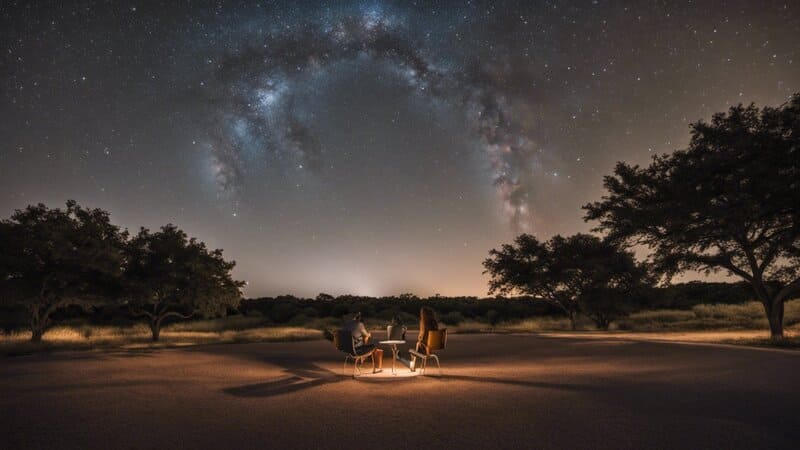
Nestled just a short drive north of Austin, around 20 miles away, Austin Community College in Round Rock offers you the chance to revel in clear skies and escape the city’s light pollution.
During the day, take your time to wander through the campus, explore its serene green spaces, and meander along the inviting walking trails. This spot becomes special for stargazing at night due to its strategic distance from the city, providing a refreshing contrast to the urban glow and a heightened view of the celestial wonders.
Big Bend National Park
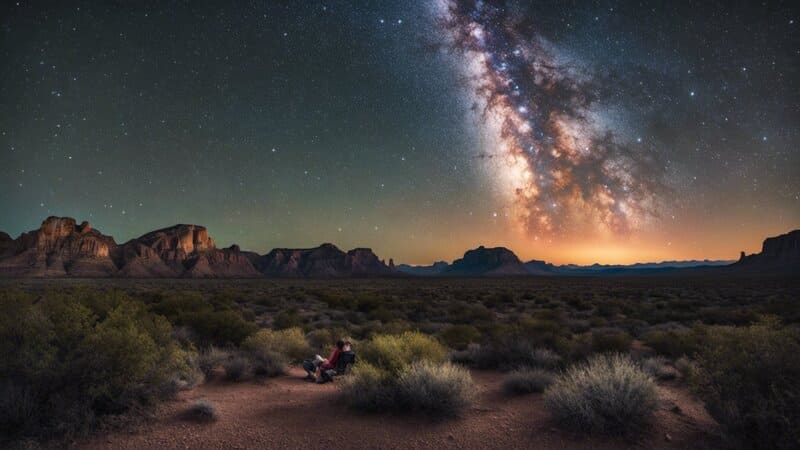
If you’re serious about stargazing, you must visit Big Bend National Park.
Yes, it’s not in Austin, but it’s well worth the trip.
Best Time to Visit Big Bend for Stargazing

Situated a considerable 400 miles to the west of Austin, Big Bend National Park invites you to savor breathtaking stargazing in the heart of Texas.
As the day unfolds, journey through the park’s diverse landscapes, venturing into its deep canyons, arid deserts, and the majestic Rio Grande River.
When night falls, the location becomes special for stargazing as it offers some of the darkest and most unobstructed skies, unveiling a sparkling tapestry of stars and galaxies that stretch to the horizon.
Blanco State Park

A mere hour’s drive from Austin, Blanco State Park welcomes you to enjoy a harmonious blend of nature and stargazing.
During the day, you’re invited to participate in a medley of activities, from leisurely picnics to engaging fishing ventures along the tranquil Blanco River. As the sun sets and the stars emerge, the park transforms into a haven for stargazing, with minimal light interference, granting you an uninterrupted view of the cosmos.
FREE STARGAZING CHECKLIST
My 5-page Stargazing Checklist will enhance your astronomical observations.
Follow this free checklist to navigate the night sky with confidence, clarity, and a sense of preparedness for a rewarding stargazing experience.

Canyon of the Eagles Resort

Approximately 80 miles north of Austin, the Canyon of the Eagles Resort beckons you with exclusive stargazing experiences and daytime indulgences.
Bask in luxurious amenities during the day, including guided nature hikes and serene moments by the picturesque Lake Buchanan. When night descends, the location turns into a cherished spot for stargazing, owed to its sequestered position away from the urban glare, fostering an atmosphere primed for celestial observation.
Devil’s Cove

Nestled within the tranquil embrace of Lake Travis, Devil’s Cove is your haven for unobstructed stargazing, far from the city’s luminous grip.
Beyond Austin’s boundaries, immerse yourself in daytime adventures that include boating, swimming, and leisurely sun-soaked moments on the water. After the sun sets, this secluded enclave emerges as a stargazing gem, its remote position enhancing the clarity of the night sky and offering an idyllic backdrop for celestial exploration.
Dripping Springs
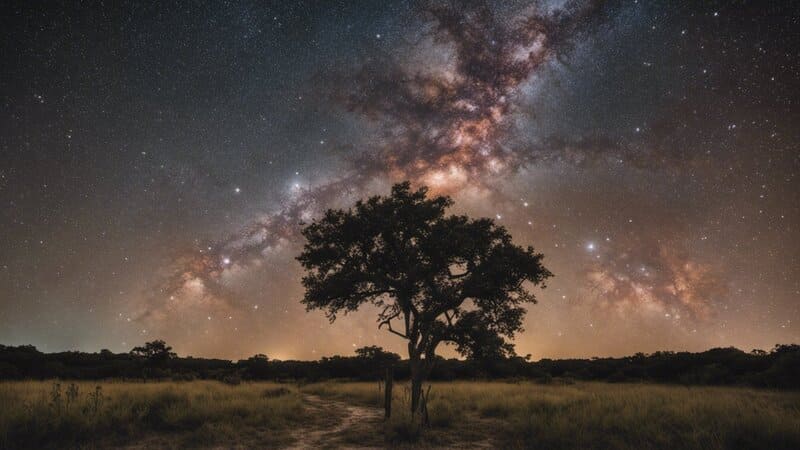
As the Gateway to the Hill Country, Dripping Springs invites you to witness starry skies less than 30 miles west of Austin.
In the daylight hours, explore the town’s charming allure, venture to local wineries, and relish the sweeping landscapes of the surrounding Hill Country. As night envelopes the region, Dripping Springs becomes a special place for stargazing, its distance from the urban lights and higher elevation combining to provide an exceptional vantage point for celestial marvels.
Eagle Eye Observatory

Nestled within the Austin area, the Eagle Eye Observatory affords you an exceptional opportunity for stargazing, bolstered by its powerful 16-inch telescope.
Delve into a day of exploration, uncovering the history of aviation and immersing yourself in the Highland Lakes Squadron of the Civil Air Patrol. As night takes over, this observatory takes on a unique significance, becoming your portal to an up-close, detailed, and transformative view of the celestial wonders above.
Enchanted Rock State Natural Area
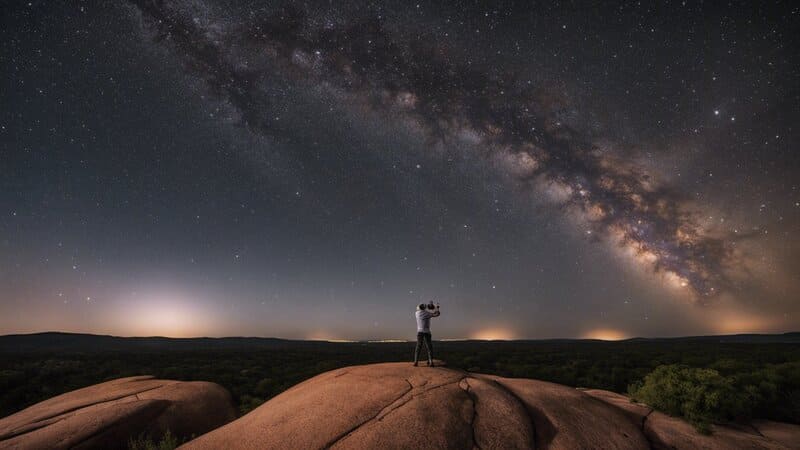
Located northwest of Austin, Enchanted Rock State Natural Area lures you into its realm, away from the city’s luminous distractions.
Traverse the majestic granite dome by day, soaking in panoramic vistas that culminate in a striking sunset display. Under the cloak of night, this natural haven transforms into a sanctuary for stargazing, with its elevated terrain and unhindered sightlines revealing an awe-inspiring canvas of stars, planets, and cosmic phenomena.
Fountainwood Observatory
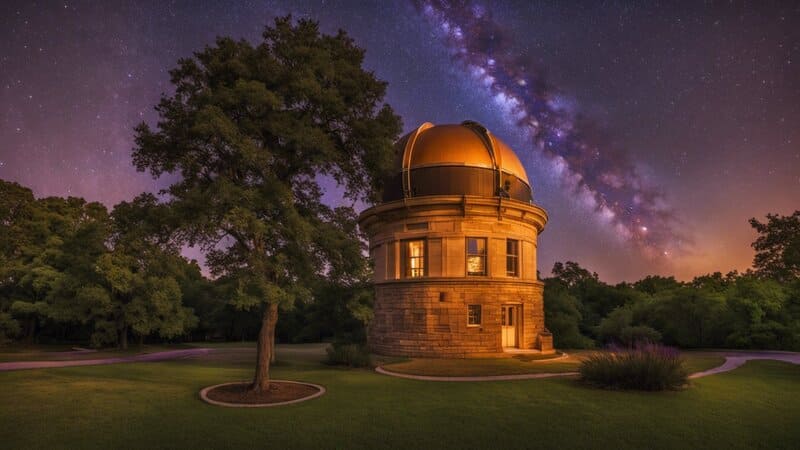
Situated at Southwestern University just north of Austin, the Fountainwood Observatory grants you access to its potent telescopes during public viewings.
Wander through the university campus during the day, absorbing its academic ambiance and exploring its intellectual offerings. As night unfurls, the observatory takes on a distinct allure, allowing you to engage in an immersive journey through the cosmos, making it an exceptional locale for stargazing.
Friendship Park
Nestled within Austin, Friendship Park offers a serene space for stargazing amidst its peaceful surroundings.
Embrace daytime enjoyment with outdoor games, leisurely picnics, and soul-nurturing relaxation. As the sun bids farewell, the park transforms into a captivating realm for stargazing, capturing your imagination with its undisturbed night sky, away from the city’s glow, and creating a unique connection between you and the universe.
Garner State Park
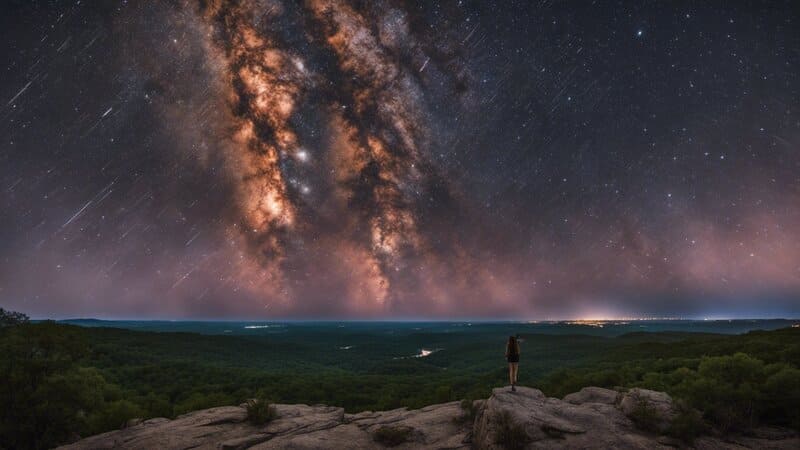
Situated a substantial 150 miles to the west of Austin, Garner State Park beckons you with its stunning landscapes and dark skies that set the stage for celestial exploration.
Daylight hours allow you to bask in the sun’s warmth, take invigorating hikes along the Frio River, and immerse yourself in various recreational activities. As night falls, the park’s remote location emerges as a haven for stargazing, presenting you with a canvas of stars that are vividly visible amidst the absence of urban light pollution.
Granger Lake Dam
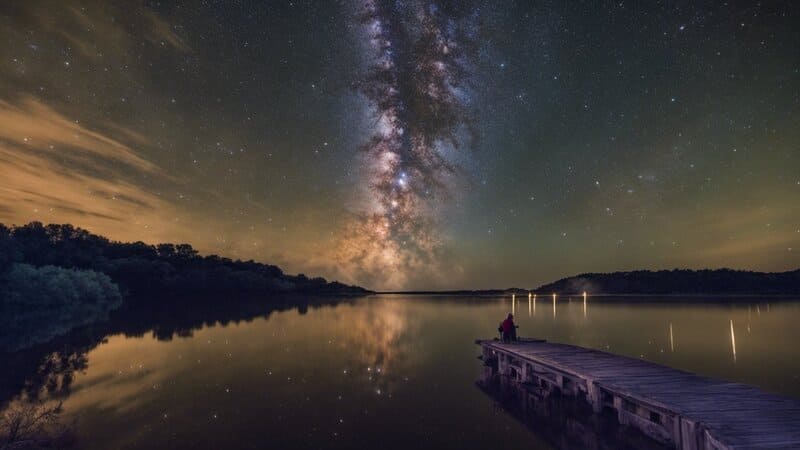
A scenic drive from Austin, Granger Lake Dam presents a breathtaking night sky view.
Nestled within the tranquility of nature, the dam area offers picnic spots and opportunities for birdwatching and fishing during the day. As the sun dips below the horizon, the dam’s minimal artificial light allows for an unobstructed view of stars and constellations, making it an ideal setting for a serene evening of stargazing.
Hamilton Pool Preserve
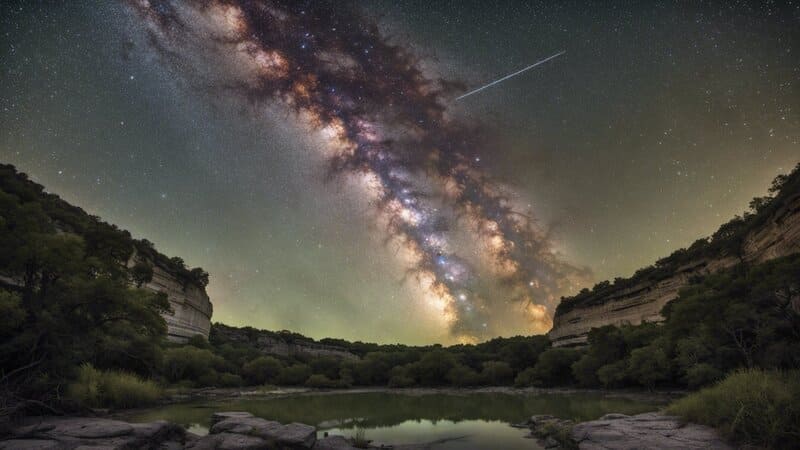
Located southwest of Austin, Hamilton Pool Preserve is a natural wonder by day and a stargazing paradise by night.
During the day, revel in the beauty of the natural swimming hole, its cascading waterfall, and the lush greenery surrounding it. As darkness falls, the preserve’s secluded location becomes a haven for observing the celestial ballet above, providing a unique blend of terrestrial and cosmic beauty.
Hill Country State Natural Area
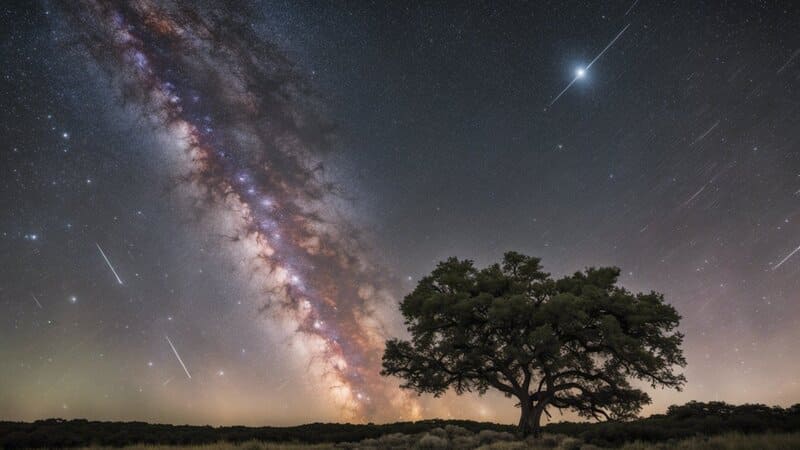
Tucked away in the picturesque Hill Country, this state natural area offers miles of trails and clear skies for an extraordinary stargazing experience.
Roam through rolling hills during the day, savoring the vistas of untouched landscapes and native flora. After dusk, the area’s pristine environment ensures minimal light pollution, making it an inviting sanctuary for immersing yourself in the wonders of the night sky.
Inks Lake State Park
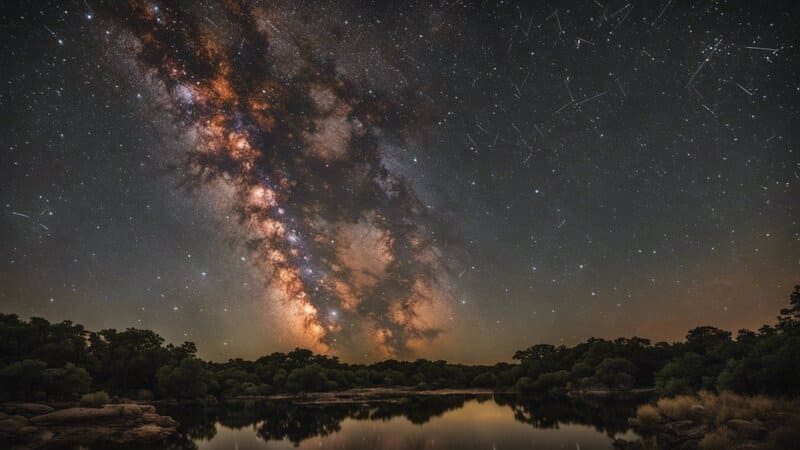
Less than an hour from Austin, Inks Lake State Park invites you to relish the day’s natural beauty and the night sky’s brilliance.
Engage in outdoor activities such as hiking, fishing, and exploring the tranquil lake shores. As evening descends, the park’s serene atmosphere provides an ideal backdrop for stargazing, allowing you to gaze upon the cosmos while surrounded by nature’s peaceful embrace.
Lake Pflugerville
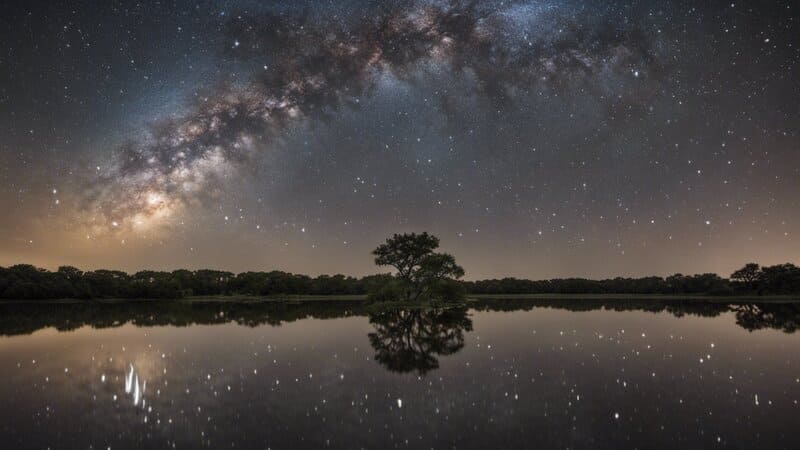
Just a stone’s throw away from Austin, Lake Pflugerville offers a local haven for stargazing enthusiasts.
Enjoy recreational activities such as jogging, fishing, and picnicking during daylight hours along the lake’s scenic trails. As twilight paints the canvas, the lake’s tranquil setting and proximity to the city create an exceptional opportunity for gazing at the stars, providing a welcome escape from urban life.
Lost Maples State Natural Area

Situated among lush foliage and vibrant fall colors, Lost Maples State Natural Area offers a unique stargazing experience that blends nature’s beauty with celestial wonders.
During the day, explore the park’s hiking trails and admire its stunning landscapes. When night falls, the area’s relative seclusion and darker skies open up a breathtaking panorama of stars, offering an enchanting setting for observing the celestial symphony above.
Mansfield Dam Park
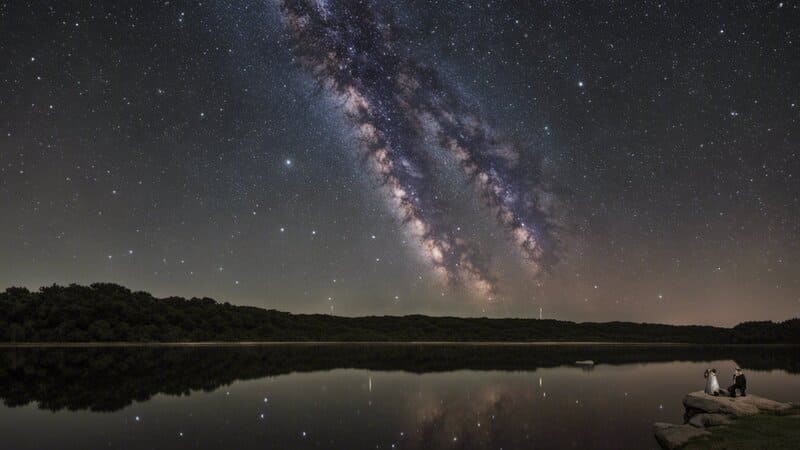
With its prime location near Lake Travis, Mansfield Dam Park is an excellent spot for stargazing, making it worth the short drive from Austin.
During daylight hours, indulge in water activities, picnics, and lakeside relaxation. As night embraces the landscape, the park’s minimal light pollution transforms it into a celestial theater, allowing you to marvel at the intricacies of the universe from a comfortable and picturesque setting.
McDonald Observatory
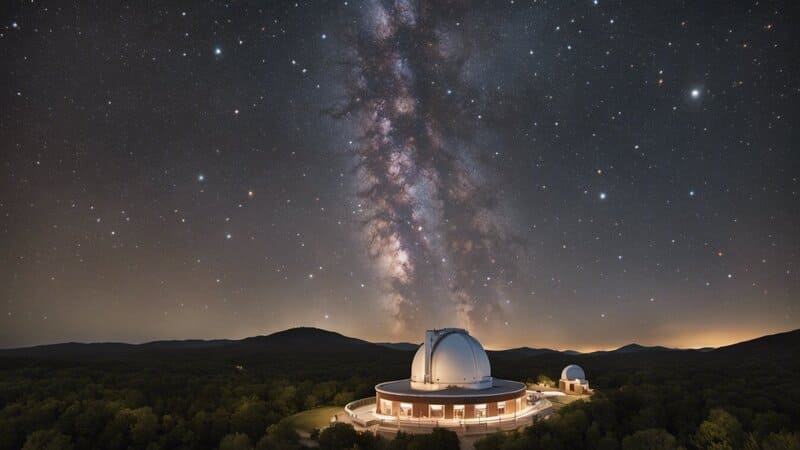
Nestled in the Davis Mountains, McDonald Observatory is a pilgrimage site for astronomy enthusiasts.
While daytime visits can provide guided tours and breathtaking views of the surrounding mountain scenery, the real magic happens at night. With its advanced telescopes and guided star parties, the observatory offers you an unparalleled opportunity to delve deep into the cosmos and unlock the mysteries of the night sky.
McKinney Falls State Park
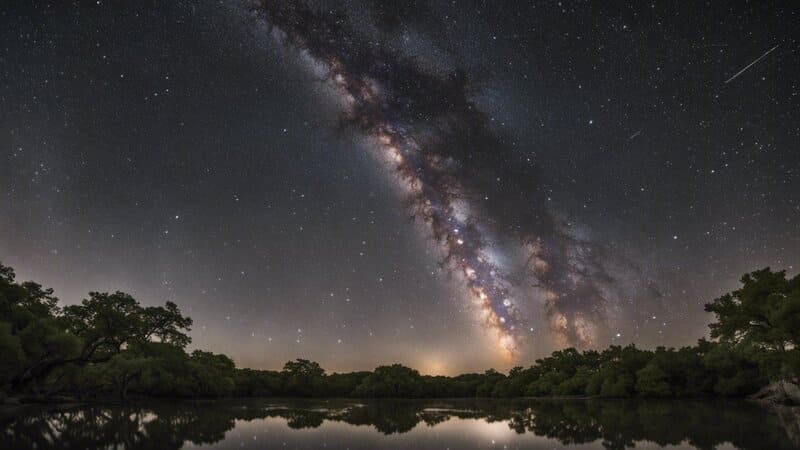
Just beyond Austin’s outskirts, McKinney Falls State Park invites you to explore its majestic waterfalls and captivating night skies.
During the day, hike along scenic trails, take in the beauty of Onion Creek, and indulge in the peaceful ambiance of the park. As the sun sets, the park’s darker skies transform it into a hub for stargazing, allowing you to witness the universe’s grandeur away from the city lights.
McKinney Roughs Nature Park
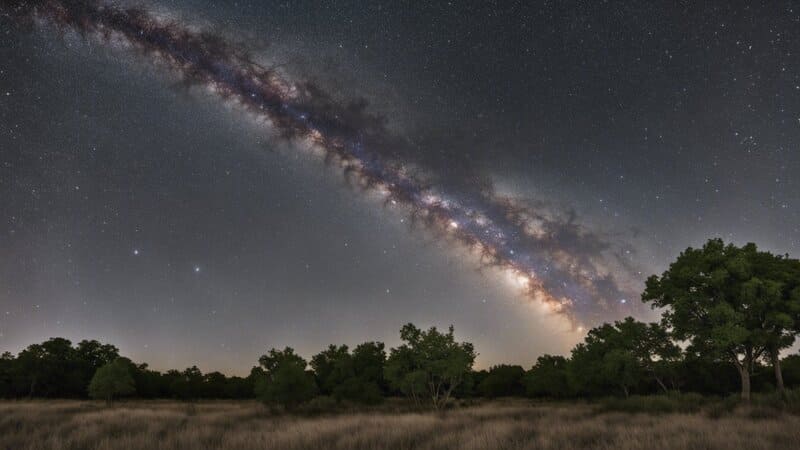
A short drive from Austin, McKinney Roughs Nature Park offers an oasis of tranquility and a perfect environment for stargazing.
Traverse the park’s lush greenery by day, enjoying the serene trails and natural beauty. When night casts its spell, the park’s escape from city lights becomes its defining feature. It provides a serene backdrop for connecting with the cosmos and marveling at the celestial wonders above.
Mount Bonnell
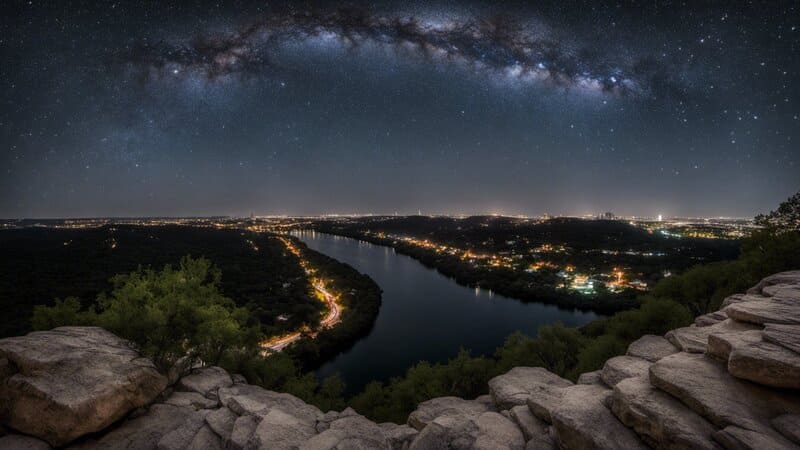
Perched above Austin’s skyline, Mount Bonnell is an iconic spot for stargazing that offers panoramic views day and night.
Ascend the hill during daylight hours to witness the stunning vista of the city and the Colorado River winding through the landscape. As darkness envelopes the scene, Mount Bonnell’s elevated position and minimal light interference provide an exceptional vantage point for observing constellations and celestial phenomena.
Pedernales Falls State Park

A nature lover’s haven, Pedernales Falls State Park beckons you to explore its captivating landscapes by day and gaze upon the stars by night.
Embark on hikes through rugged terrains, marvel at the picturesque waterfalls, and savor the park’s natural beauty during the daytime. After the sun sets, the park’s serene ambiance and low light pollution make it an enchanting locale for immersing yourself in the splendors of the night sky.
Reimer’s Ranch Park

A short journey from Austin, Reimer’s Ranch Park offers a versatile outdoor experience from day to night.
Engage in activities like rock climbing, swimming, and bird watching during daylight hours, embracing the park’s diverse offerings. As the sun dips below the horizon, the park’s relatively low light pollution and peaceful surroundings transform it into a prime stargazing spot, allowing you to witness the cosmos’ grandeur.
South Llano River State Park
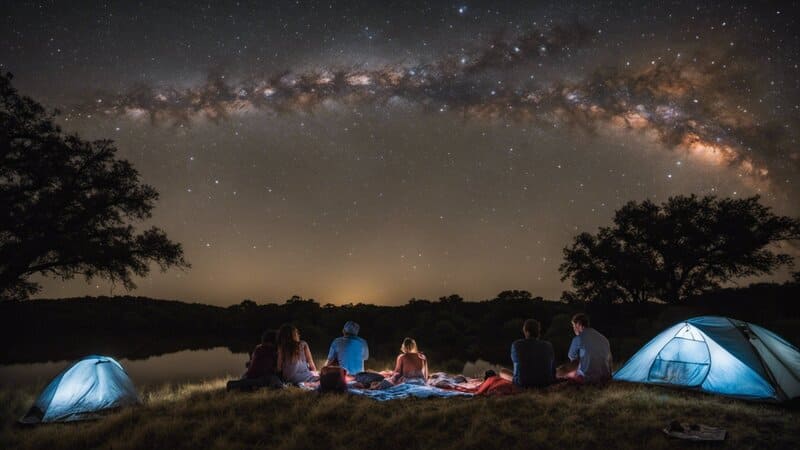
Nestled in a remote and picturesque setting, South Llano River State Park provides a serene environment for stargazing, just a short drive from Austin.
During the day, enjoy the beauty of the park’s natural landscapes, explore the riverside trails, and experience the tranquility of the surroundings. As evening sets in, the park’s recognition as an International Dark-Sky Park ensures an unobstructed view of the stars, offering a remarkable celestial spectacle.
Edwards Park
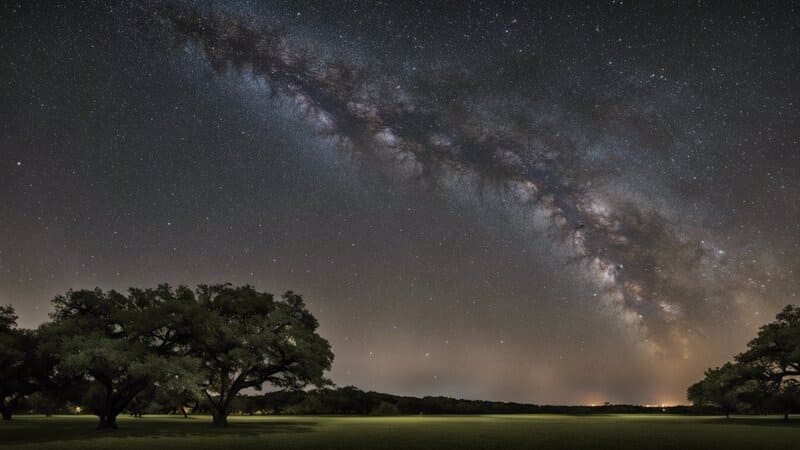
A peaceful stargazing sanctuary near Austin, St. Edwards Park boasts minimal light pollution and a serene atmosphere that enhances the nighttime experience.
By day, explore the park’s lush foliage, unwind by the creek, and enjoy the tranquility of the natural surroundings. As darkness falls, the park’s secluded location and proximity to the city create an exceptional opportunity to witness the celestial wonders that adorn the night sky.
The City of Elgin

A short 25-mile journey from Austin, the City of Elgin offers a charming small-town backdrop for remarkable stargazing.
During the day, explore the town’s historic sites, local eateries, and scenic spots. As night descends, Elgin’s darker skies provide an ideal atmosphere for observing constellations, planets, and other celestial marvels, making it an inviting destination for city dwellers and stargazing enthusiasts.
University of Texas, Austin

Within the heart of Austin, the University of Texas houses the Painter Hall Observatory, a hub for stargazing enthusiasts.
During the day, soak up the academic atmosphere and explore the campus’s cultural offerings. As night falls, the observatory’s public viewings on Friday and Saturday nights open a window to the cosmos. This allows you to peer through advanced telescopes and appreciate the celestial beauty above.
Westcave Outdoor Discovery Center
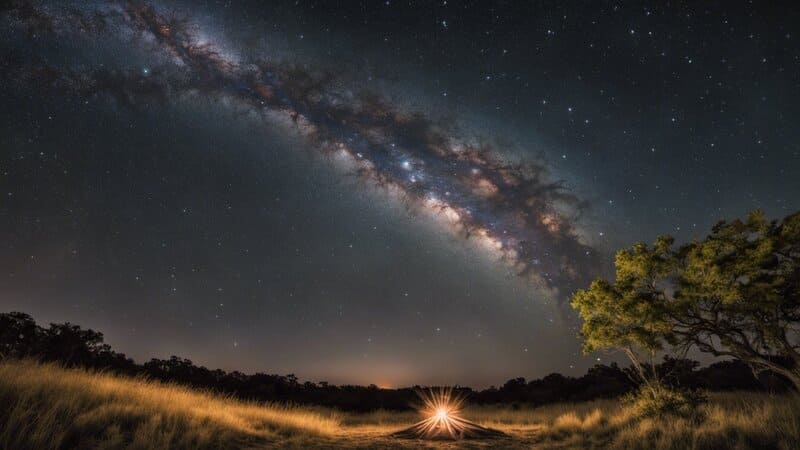
A paradise for astronomy enthusiasts, the Westcave Outdoor Discovery Center invites you to participate in star parties and embark on a journey through the night sky.
By day, explore the center’s natural wonders, lush trails, and the beauty of its grotto. As the sun sets, the center’s expert-guided star-watching activities and telescopes offer an unparalleled opportunity to delve into the celestial realm, combining education and awe-inspiring experiences.
Observatories in Austin
University Observatories
The University of Texas at Austin
UT Austin has an observatory open to the public for stargazing events. They house several telescopes for your viewing pleasure. Mark your calendar for their star parties, where you can peek through multiple scopes.
Fountainwood Observatory at Southwestern University
Just north of Austin, Southwestern University operates the Fountainwood Observatory. This observatory offers public viewings, so watch for their events. You’ll explore the night sky with their 16-inch telescope!
Private Observatories
Eagle Eye Observatory
Owned and operated by the Austin Astronomical Society, the Eagle Eye Observatory is your gateway to the celestial wonders! With a variety of telescopes available, members of the society can:
- Observe planets, stars, and galaxies
- Attend star parties and events
- Dive deeper into astronomy with fellow enthusiasts
Don’t worry if you’re not a member. They host public events too! So next time you’re looking to gaze upon the cosmos, check out these observatories around Austin.
Star Gazing Events
Star Parties
Star parties are events where people gather to view the night sky, and Austin is no stranger to these celestial celebrations. One of the best places for star gazing is the Texas Hill Country, away from city lights:
- McKinney Roughs: This nature reserve offers dark skies, making it an ideal location for star parties. Remember to bring your telescope to enhance your experience!
- International Dark Sky Park: South Llano River State Park, about 2 hours from Austin, is recognized by the International Dark-Sky Association. Join your fellow stargazers for a breathtaking view of the night sky here.
Remember, you must let your eyes adjust to the darkness at star parties for the best experience. So go ahead and make the most of these gatherings!
Night Sky Festivals
Austin also hosts night sky festivals throughout the year, offering a fun and educational way to get the whole family involved in exploring the cosmos.
Texas Night Sky Festival
Celebrate the beauty of the night sky at this annual festival. It features:
- Telescopes for public use
- Talks by astronomy experts
- Hands-on activities for kids
- Exhibits from various organizations
Stars in the Park
Organized by the Austin Astronomical Society, this monthly event allows you to explore the cosmos under guidance from expert astronomers. They’ll help you identify constellations and maximize your telescope usage.
So mark your calendars for these night sky festivals and immerse yourself in the universe’s wonders while staying close to home in Austin. Remember to pack your telescope, bring your curiosity, and enjoy the journey through the starlit sky!
Combatting Light Pollution
Austin’s stargazing experience can be dimmed by light pollution. But don’t worry! You can enjoy the starry night sky by visiting areas with lower Bortle ratings. The Bortle scale, ranging from 1 to 9, measures how much light pollution affects your view of the night sky. The lower the rating, the better the stargazing!
Here are some actionable tips to combat light pollution and enjoy dark skies in Austin:
- Support local initiatives – Join groups of Central Texans aiming to dim outside lights during Night Skies Month to help reduce light pollution.
- Stargazing spots within one hour of Austin – Escape the city lights to enjoy breathtaking views of the big Texas sky.
- Go further for darker skies – There are locations with Bortle ratings as low as three, offering pristine stargazing opportunities. Even if it means a longer drive, check out places like Lost Maples State Natural Area for incredible views under the dark skies.
Keep these spots and tips in mind, and you’ll be all set to enjoy the wonders of the night sky in and around Austin. Get your telescope ready – the stars await you!
Astronomical Phenomena
Meteor Showers
Hey, stargazers! In Austin, you’re in for a treat regarding meteor showers.
The Perseids, known for their dazzling display of shooting stars, can be spotted from dark sky parks like Blanco State Park. Remember to bring a cozy blanket and maybe some snacks as you lie under the beautiful night sky.
Time your visit around mid-August to witness the peak of the shower.
Night Sky Photography
Capturing the beauty of the universe in a photograph is a fantastic feeling. Here’s your quick guide to night sky photography in Austin:
- Location: Think about places that have minimal light pollution. Parks like Colorado Bend State Park or McKinney Roughs Nature Park offer ideal dark skies.
- Equipment: A DSLR camera and a sturdy tripod will do the trick. Remember to use a wide-angle lens to capture more of the Milky Way.
- Settings: Experiment with manual settings on your camera. Start with a high ISO, open aperture, and long exposure time of about 20-30 seconds.
- Timing: Plan your shoot on a clear, moonless night for crisp, stunning photos of the constellations and other celestial events.
In addition to meteor showers and night sky photography, Austin also offers several hiking opportunities and admiring the stars. The Davis Mountains and Fredericksburg are popular spots for stargazing and taking in the beauty of our universe.
Stargazing for Kids
Stargazing is an exciting activity for kids of all ages. It sparks their curiosity and sense of wonder and provides an opportunity to bond with friends and create lasting memories.
In Austin, there are several kid-friendly locations where you and your little astronomers can explore the night sky.
One such spot is Friendship Park. Families can lay blankets, relax, and enjoy the celestial show above. But before you head out, be sure to:
- Check the weather forecast for clear skies
- Keep an eye on the moon phase (new moon nights are best)
- Bring a red flashlight to preserve night vision
Now that you’re prepared, here’s a simple activity you can try with your kids at Friendship Park:
- Find a spot away from streetlights or other bright lights
- Let your eyes adjust to the darkness for about 15 minutes
- Look up and try to identify a few constellations together using a stargazing app or printed sky map
Another option for Austin’s young astronomers is a stargazing class.
Organizations like Starry Sky Austin offer hands-on, experiential lessons for children aged 8 and up. These classes provide a safe and supportive environment where kids can learn about astronomy and stargaze using telescopes.
To make your child’s stargazing experience even more memorable, try incorporating some fun games or activities like:
- Constellation Connect-the-Dots: Draw constellations using glow-in-the-dark paint on black construction paper
- Starry Storytelling: Makeup stories about the distant celestial objects you’re observing
- Astronaut Freeze Tag: Let kids pretend they’re astronauts exploring a new planet under starlit skies
Whichever activities or locations you choose, stargazing with your kids in Austin is bound to be an unforgettable adventure. Just remember to dress warmly, pack some snacks, and always gaze in awe at the vastness of the universe before you.
Stargazing in Texas Beyond Austin
While Austin offers some great opportunities for observing the night sky, fantastic parks and locations beyond the city provide even better experiences for gazing at the stars. So, grab your blanket and telescope, and dive into a few notable spots in Texas.
Enchanted Rock State Natural Area, located about an hour and a half west of Austin, is ideal for stargazing. With beautiful views of the Texas Hill Country, this spot provides a clear and dark canvas for observing the heavens.
In addition to Enchanted Rock, consider visiting South Llano River State Park in Junction, TX. Designated as an International Dark Sky Park, it offers spectacular night sky views and some of the darkest skies in Texas.
Here are a few more stargazing spots you might enjoy:
- Blanco State Park: A park within an hour of Austin that provides terrific opportunities for stargazing as you escape the city lights.
- Big Bend National Park: Known for its vast dark skies and unobstructed views of the Milky Way, this park is a stargazer’s paradise.
- McDonald Observatory: Located in the Davis Mountains, this observatory offers public star parties and other educational events, perfect for immersing yourself in the celestial world.
Be bold and venture beyond Austin for some spectacular stargazing opportunities. Remember, the darker the sky, the brighter the stars shine for your enjoyment.
Free Google Map of the Best Stargazing in Austin
Here is your free Google Map of the Best Stargazing Austin offers.
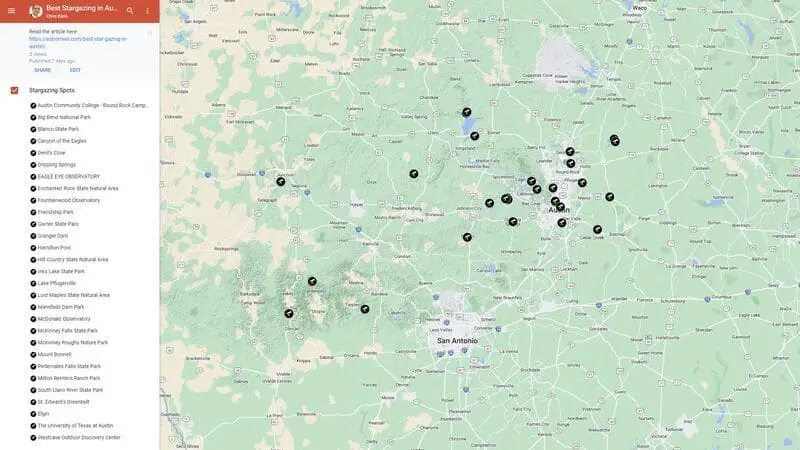
Frequently Asked Questions
Is it possible to view the Milky Way in Austin or its surrounding areas?
Yes, you can view the Milky Way in Austin’s surrounding areas. To increase your chances, head to a location with minimal light pollution, such as a state park within an hour of the city.
Are there any regular star parties in the city?
Indeed, there are regular star parties hosted in Austin. The Austin Astronomical Society often organizes events, and some parks might also host gatherings for stargazing enthusiasts.
What is the Austin Astronomical Society, and how can I join?
The Austin Astronomical Society is a group of astronomy enthusiasts who gather to share their passion for stargazing. You can join by visiting their website and following the membership instructions provided.
When is the optimal time to see stars in Texas?
The optimal time to see stars in Texas is during clear, moonless nights. Typically, this occurs in late spring and early summer, but good stargazing conditions can happen throughout the year.
Which nearby state parks offer the best stargazing opportunities?
Some state parks near Austin with excellent stargazing opportunities include Lost Maples, Pedernales Falls, and Enchanted Rock. These parks have low light pollution, making them ideal for viewing the night sky.
Summary: Best Stargazing in Austin
Thank you for reading my article about the best star gazing in Austin. Austin is a magnificent location for stargazing enthusiasts, offering an array of picturesque spots to appreciate the beauty of the night sky. Just a short drive from the city, Enchanted Rock State Natural Area is a popular stargazing destination in Texas. The park’s natural beauty and dark skies provide breathtaking celestial views.
Canyon of the Eagles Resort offers a prime location for relaxation and stargazing, while Inks Lake State Park is another excellent spot for enjoying the night sky. If you’re seeking a more educational experience, the Eagle Eye Observatory provides telescopes and expert guidance to enhance your stargazing adventure.
Austin also has some excellent resources for amateur astronomers. For instance, the University of Texas hosts periodic star parties at the Robert Lee Moore Hall Observatory, where the public can attend. Additionally, local planetariums, such as the Texas Museum of Science and Technology and Girlstart, provide entertaining and informative programs related to astronomy.
To summarize, Austin offers a variety of enjoyable stargazing locations suitable for all ages and experience levels. With these options in and around the city, you’ll have countless opportunities to marvel at the stars and bask in the wonder of the cosmos. Grab a blanket and head to one of these spots to create lasting memories under Austin’s beautiful night sky.
Happy Stargazing!
Read my other articles in my Best Stargazing in US series:




